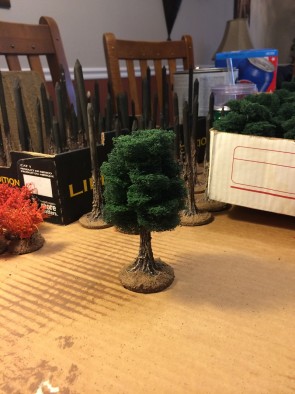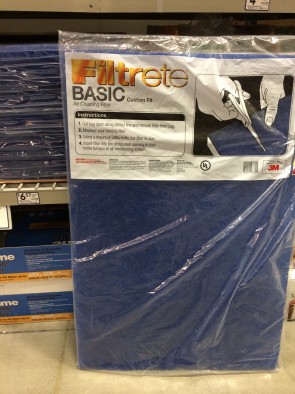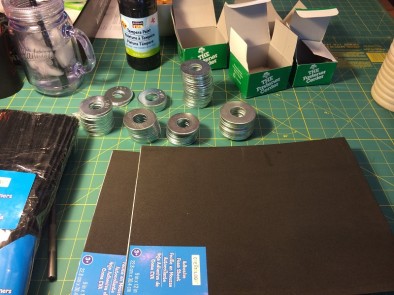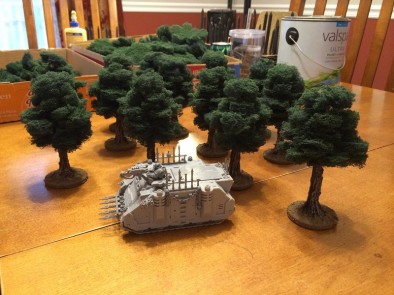Terrainscaping! How To Make Awesome Tabletop Trees!
July 3, 2014 by crew
Building trees that are durable and look good for the miniature gaming table is a difficult task. The internet is full of ideas, tutorials, You-Tube videos, and is a great source of inspiration. Most tree-making tutorials are for the railroad modeller. They look great, but are too delicate or detailed. Miniature gamers need terrain that is modular, durable, and cost effective. The following is a tutorial that combines many elements of terrain building to create trees fantastic that will last many battles.
I’ve been building terrain for nearly three decades and was an outrider for Games Workshop in the ‘90s. I’m building the following trees for a new convention in Anchorage, Alaska called “AK Battle Brothers”. My goal was to start off building a batch of eighty (80) trees – plenty for two forest boards or many scattered forest tiles across multiple boards.
The Trunks
This current tree project is the result of many experiments with wires, real branches, foam, commercial tree kits and many other ideas. But they were all too complex, too time consuming or expensive. Recently I thought about the hedges built out of scrubbing pads many years ago. Then I thought of a tree with branches, and the idea of stacking scrubbing pads on top of each other came to mind, all cut to different sizes and shapes. But cutting up the wives scrubbing pads under the kitchen sink was not an option. So I looked elsewhere and eventually found a great replacement medium – disposable furnace filters!
The tree trunks and the base was a simple solution - wooden dowels of various sizes cut to different lengths and metal fender washers for the base to stabilize the tree. The sizes I chose for these trees are for 28mm gaming, but the same concept can easily be scaled to 15mm or other scales. For the tree sizes I chose 5”, 6” 7” and 8” tree trunks. The 5”-6” trunks are ¼” diameter dowels, and the 7”-8” trunks are 3/8” diameter dowels. I shaped the top to a point to make it easier to push the filter material on the trunk. Here are some of the materials I gathered for this project.
The sticky foam serves many functions (sticky felt should work too, or any material for that matter). For one, the sticky foam is easy to mount on the washers. If they don’t quite fit, just let them hang over the edge a bit, cut them out and move them to another area to cover the rest of the washer.
Shown here is a picture of the wooden dowels. I wrapped them in a bundle with tape spaced along the length, and cut out a handful at a time with a hobby saw. Sharpening them was a chore – the electric pencil sharpener I used burned up in the process. An exacto knife worked easy enough.
To mount the trunks, press them on the sticky foam in the centre of the washer. That’s the second function of the sticky pads. Then I spooned a thick mixture of sand and yellow wood glue into the hole and around the tree trunk.
Let this mixture dry overnight. Do be careful. The tree trunk looks solid, but it is still fragile. Several days of curing will set the compound rock hard. But they should be solid enough for the next stage – the bark. I thought of many ways to build up the body of the tree, and what material I should use for bark. Regular wall spackle is too brittle and normal wood putty too thin or does not have enough texture. The wood putty that seemed the best is the one shown above. High strength is what you are after.
To apply the wood putty, dip your finger into the bowl of putty and smear it onto the washer. Squeeze it around the trunk and shape it to the edge of the washer. Then turn the tree upside down, and “pull” the putty with your finger onto the trunk. Alternate with your fingers – reserve your pinkie for the last touch ups, as it helps to shape the roots. Shape it as rough or as smooth as you like. Here are my results.
The wood putty is still brittle once it dries. So I mixed up a batch of wood glue and black paint. The paint is so that I can see what area I covered, and also provides the undercoat – you could use grey, or dark brown, or even white. I chose black as I wanted my trees to look aged. And the wood glue creates a nice hard shell to protect the wood putty!
Let this dry overnight and then dry brush the trunk with the colours of your choice. Use at least two colours. I used three in this example. Take your brush and wet-dry brush it using sideways motions. Run the side edge of the brush up the trunk. If you swish the brush across the trunk sideways you will get horizontal streaks and that looks terrible. Experiment - take your time. (My cat Raspberry)
Next I sanded the base – you can use the same black paint and glue mixture. I used playground sand. I used to scavenge this in the dead of night from the neighbourhood playgrounds. But that requires washing, sifting and you find all sorts of things like glass in your sand. This time around I chose to just buy a bag of sand at the hardware store. Easy to acquire, it’s clean sand, and contains no sharp glass (speaking from experience here).
Then paint and dry brush your sand. Shown here is a new batch of paint I use for all the other terrain I’m building. A smaller paint jar will be fine if you only build one table of terrain. I feel it’s important to match all your terrain as best you can, and paint is the easiest way to ensure that.
The Foliage
The filter material I chose was about one inch thick, blue plastic fibres. It’s the fibres that you need. Think of the old Games Workshop hedges. It’s the same concept. To create the shape of the tree, I decided that the small and medium trees will have a three inch (3”) diameter at the widest point, and the taller trees four inches (4”) in diameter. As most trees have a round or egg shape to the body, I chose to cut up the filter into one inch, two inch, three inch and four inch strips and then into squares. I chose to spray paint the material with black first. But you can wait for that until later if you want. Cut the material into long strips and then into squares and keep them in separate piles or boxes.
Then shape each square by rounding the corners and cut V shapes out of the sides. Create random shapes. Use sharp scissors but be careful. Last night I discovered that bending the rounded shape and cutting out a chunk at the edge will give you a nice result and quicker than cutting the V shapes. But clover leaf like designs (with 3, 4 or even 5 leaves) worked best for me. (For the crown of the tree, you want to cut up a one inch square by rounding it, and then shape this into a dome. Rough up the top a bit. The idea is to glue the bottom flat side of this dome that is now about ¾”-1” thick on the final layer, pinned over the sharpened point. See more below.)
After you shape the square, it’s now time to pull it apart. You want to separate the one inch thick material into two half inch thick layers. Do this by snipping sideways halfway into each of the clover leaves. Then snip into the centre. Hold the foliage gently on the top and bottom, and peel each half away – it’s perfectly fine and desirable to pull and get more body out of the fibre material. This image is the only one I have that shows this concept on a square piece. Tear the edges as much as you want, and cut up any clean straight lines. A little shaping is all you need.
This process takes several evenings. Alternate working on the tree trunk drying time with foliage work and you can get a lot of work finished inside a week. Let’s talk about flocking real quickly.
Terrain Maker has a huge selection of colours and ground flocking. For these trees I used the dark green powder. But any colours will work. Just start with a dark one. Later I will layer some lighter colours as highlights. Here is a picture of the selection at my local store, Hobbycraft, in Anchorage, Alaska.
The next step is to get that flocking to stick to your fibre filter material. Lay them out in an area where you don’t have to worry about wind and dirt, or leaves blowing on your work. Lay out each layer of the clover shaped foliage as tight as you can. Then spray it with green – I chose a nice camouflage green. Just a slight dusting is all you need, if you sprayed the fibres black or brown. The idea is to create the illusion of depth. And if any green powder rubs off, you won’t notice it.
And immediately afterwards, spray everything with a good quality spray glue. Do not buy cheap spray glue. Trust me. It’s not worth the hassle. Then sprinkle your flocking material over the foliage as shown – let it fall like snow from 2 feet up or so. Let this dry overnight. Rinse and repeat if you feel they are dry enough that evening – I just closed the garage door and turned up the heater. It takes patience flipping each one of the foliage pieces over.
Let your foliage dry for a few days. When it does no longer feel spongy and moist, they are ready for mounting. Gather your trunks and start spearing on the layers. I started with a small two inch (2”) layer or two, to create the smaller bottom branches.
Push them down until you get to the wood putty bark. Tack it down with glue (I used wood glue, which will run down your tree trunk) or hot glue (that’s what I will try next). I might wrap the trunk below the branches with aluminium foil next time. This will protect the tree trunk from running glue, and shield the trunk from later spray glue.
Layer the three inch (3”) clover leaf designs in a random fashion for the bulk of the foliage, and try to layer a branch over a gap below - when you near the top of the tree, use small 2” patches to give the tree a nice shape. Cut a hole in the centre with the exacto blade to make it easier to mount them on the wooden dowel trunk.
The crown of the tree is a one inch square that you did not cut in half and shaped into a dome. Glue that on top. Cut a slot for the point of the dowel and stick that on.
Your trees will assemble quickly. I created this entire batch in one evening. Here are some pictures to show the scale. Excuse the unpainted Rhino, but that was the most immediate object at hand.
Some foot sloggers – once again, ancient miniatures from the glory days of Games Workshop gaming, hence the light green bases.
I placed the trees on their side so that the glue stops running down the trunks. It made a bit of a mess, but it stopped once they lay sideways. The picture also serves to show you a scale. These are 1” squares (25mm) on the mat.
By creating slightly larger and smaller trees, and even some leaning, you get a nice realistic look and feel to your forest. Shown here are the tall 8” trunks which I have yet to work on.
Using two filters of about 32”x20” I managed to build all these trees. I have to buy more material for the rest of the trees.
The next step is to cover the trunks with foil, then spray the trees with spray glue and more green flocking to cover the sides. Then flock several light layers of lighter coloured powder to simulate light on the upper branches and leaves. I’ll probably just set them all side by side for the final layer, spray the glue over the top and dust them lightly from up high.
My next project is to try Pine Trees. I saw a video on You-Tube where a guy used a drill and a sanding disk to shape his pine trees. I might try that, and run the wood putty all the way up the trunk, a bit lighter and not so thick. Then shape the filter material into star shapes, and let a lot of gaps show the trunk. That requires finishing the foliage beforehand. We will see…perhaps that will be another article.
Thomas Hoellering
If you would like to write an article for us at Beasts of War then please get in contact at [email protected] and we'll help you get started!
"If you swish the brush across the trunk sideways you will get horizontal streaks and that looks terrible. Experiment - take your time!"
Supported by (Turn Off)
Supported by (Turn Off)
"Do not buy cheap spray glue. Trust me. It’s not worth the hassle..."
Supported by (Turn Off)































![How To Paint Moonstone’s Nanny | Goblin King Games [7 Days Early Access]](https://images.beastsofwar.com/2024/12/3CU-Gobin-King-Games-Moonstone-Shades-Nanny-coverimage-225-127.jpg)












































































Damn, those look fantastic! Really impressed.
Great tutorial Tom, well adapted from your FB post. Kudos!
Thanks, those look awesome. Its another great technique to have in the terrain toolbox.
Here is another technique I saw not to long ago thats really easy and has a great effect if anyone is interested.
https://www.youtube.com/watch?v=ntmEP46g40Q&list=UU9Eaq7e8PGCtWTAS4EHCWVA&index=8
Rubbishinrubbishout has lots of good terrain advice and tutorials
Very nice!
Awesome tutorial. Thank you so much!
Having a mixture of these and the BoW trees would be great on a table.
awesome, I will definitely be doing some 😉
Saw these on the Bolt Action forum on FB, so glad you did an article I can bookmark and come back to easily. Never ceases to impress me. All this terrain stuff makes me want to build, despite the fact I have neither the resources nor space for it. For that I both love and hate all the inspiration terrain stuff……but mostly love.
Great article. Leaves me wondering if you have any other terrain making ideas. There must be a lot of techniques other community members use but have not felt the need or had the platform to share.
Most ingenious and very effective looking. And the tutorial is very sensibly illustrated with great photos and lots of text.
Very interesting, had not thought of the stacking with filter material. May give it a go once I have found some suitable filter material in the UK
Great article and the end result has all the feel of an expensive model tree with the durability a wargamer needs. Well done.
Nice! Looks great. I notice there are some shrubs next to the finished trees, possibly a good way to use the scrap material?
Nice work. I’ll be at Battle Brothers so it will be cool to see your work in person!
Very nice work love this!!!!!
They look awesome! Anyone have a suggestion on material to use for the foliage as furnace filters don’t seem to be too common
Pond pump filters
Thanks Barretem30, I picked up. A cheap broom head with already green fibre bristles but struggled as my garden wire wasn’t thick enough but after watching the link you mentioned picked up a 5m length of gutter protector for less than £6 on eBay-even easier so cant wait to give it a try. Also saw a method on te Infinity forums where some uses golf tees upside down for trunks and just sticks aquarium plant stuff on top, sounds rubbish but looked really cool.
Thank you for the kind reviews and additional ideas you shared. That’s how the scratch building hobby grows and learns, by sharing what we discover. I like many commercial products and not looking to upset anyone with this guide – but I just really enjoy making something out of common objects and just have fun with it. I sent Ben a part 2 of this tutorial which he will be posting soon. Just a few additional pictures of what the trees look like when completed. When I run my convention thisAugust I will take some additional pictures to share. Cheers… Read more »
I finally did work on Pine Trees last year and almost completed them but then lost steam. The batch is about another 80 trees and they turned out very nice. A friend shaped the dowels for me. Cutting the star shaped branches was triple the work as the work above – it nearly drove me to quit the project, but I stuck to my goal. If you wish to see some pictures or a tutorial I can put something together for you.
Cheers,
Thomas